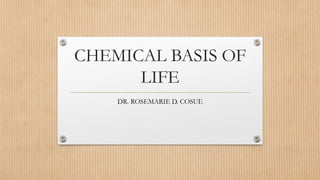
CHEMICAL-BASIS-OF-LIFE Chemistry presentation .pptx
- 1. CHEMICAL BASIS OF LIFE DR. ROSEMARIE D. COSUE
- 2. • All life processes involve chemical reactions • Ex. Ca in muscle contraction • Na, K in nerve impulses •
- 3. • There are 92 naturally occurring elements (112 known) • Living organisms require about 26 of these elements (table 2.1) • About 96 (by mass) comes from Oxygen (O), Carbon (C), Hydrogen (H), and Nitrogen (N) •
- 4. • Atoms- smallest complete unit of an element • Subatomic particle Charge Location • proton nucleus • neutron none nucleus • electron - surrounds • nucleus • Atomic number () number of protons (number of electrons in neutral atom) • Mass number (AM) number of protons number of neutrons •
- 5. • Isotopes- atoms of same element, different mass (due to neutrons) • Ex. C-12 and C-14 • Radioactive isotopes used in many medical tests (ex. I-131 for thyroid activity)
- 6. • Ions- charged particles (form ionic bonds) • Bonds (ionic and covalent)- lose, gain or share electrons in order to fill valence shell (stability) • All atoms want 8 e- in their outermost shell
- 7. • BondsDue to electronegativity! • Ionic- gt1.7 • Polar covalent- 0.4- 1.7 • Covalent- lt 0.4 •
- 8. • Molecular formula- represents the numbers and types of atoms in a molecule • Ex. H2O , C6H12O6 •
- 9. • Catalyst- effect the rate of reaction without being changed by the reaction • Biological catalyst enzyme (-ase)
- 10. • Inorganic CompoundsWater (60 RBC, 75 muscles, 92 plasma) • Participates in chemical reactions (ex. Hydrolysis) • Carries chemicals within body (good solvent) • Can absorb and transport heat (homeostasis) heat capacity • Requires large amount of heat • to change state heat of • vaporization • Serves as lubricant • Protective function (cushioning)
- 11. • Oxygen- used to release energy from glucose • Carbon dioxide- waste of metabolic processes
- 12. • Inorganic salts- provide Na, Cl-, K, Ca, Mg, PO4---, CO3--, etc. • Electrolytes- substances that release ions in water (will conduct an electrical current) • Acids- release H ions • Bases- release OH- ions
- 13. • pH scale measures hydrogen ion concentration • pH 7 neutral • pH gt7 basics (more OH- than H) • pH lt7 acidic (more H than OH-) • Normal blood pH for humans is 7.35 to 7.45 • If gt , alkalosis • If lt , acidosis • Buffers- maintain pH
- 14. • Organic CompoundsCarbohydrates- sugars, starches, glycogen, cellulose 2-3 body weight • Plants- starches and cellulose (cannot digest) • Animals- source of energy- stored as glycogen
- 15. • Monosaccharides- 3 to 7 carbons • Ex. Glucose, fructose, galactose • Carbohydrate • utilized by the • cell • Many C6H12O6 fructose
- 16. • Disaccharides- 2 monos combine by dehydration synthesis (condensation) • Ex. Sucrose • Broken apart by hydrolysis (add water) •
- 17. • Polysacchride- 10-100s of monos • Ex. starch •
- 18. • Lipids- 18-25 in lean adults • Contain C, H, O - neutral • Fats- concentrated energy stored in adipose tissue •
- 19. • Triglycerides • Glycerol 3 fatty acids • Monounsaturated- one double bond • Polyunsaturated- more than one double bond • Saturated- no double bonds • liquid solid
- 20. • Phospholipids- polar head and 2 non-polar tails (membrane) •
- 21. • Steroids- cholesterol, sex hormones, cortisol, etc. • cholesterol testosterone
- 22. • Proteins- 12-18 in lean adults • Structural and physiological enzymes • Made of amino acids (20)- held by peptide bonds • 3D shape held by H-bonds (denatured with heat) • Fibrous (structural) or globular (functional) •
- 23. • Levels of Structure Secondary Primary Tertiary Quaternary
- 24. • Nucleic acids • Base sugar phosphate • DNA and RNA • ATP- provides energy for the cell • RNA ATP DNA